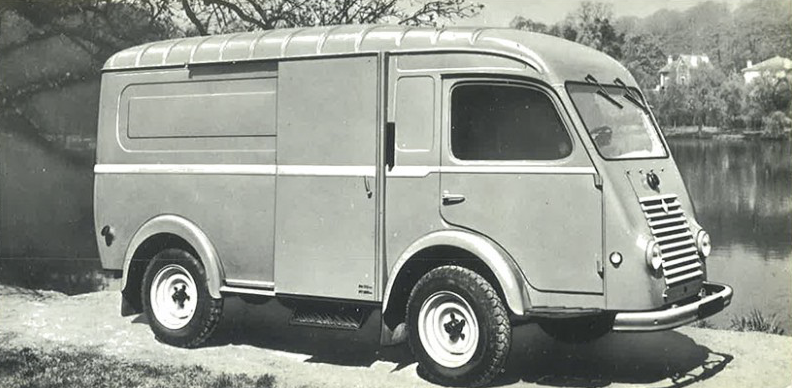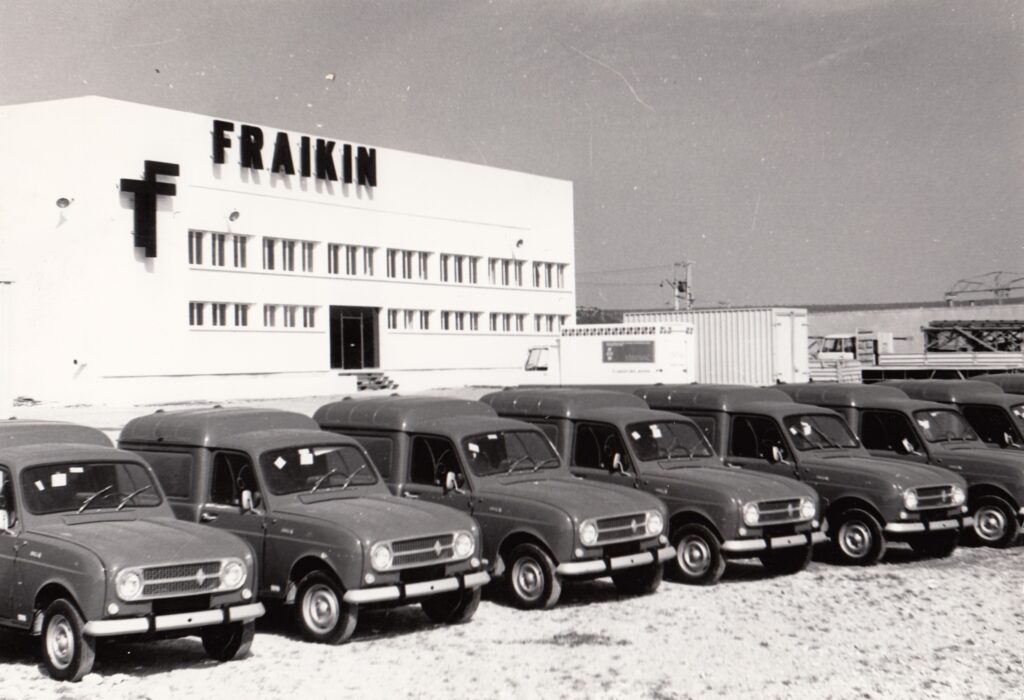80 Years at the forefront
Explore Fraikin’s 80-year legacy: from a visionary post-war startup to a pioneering force in Europe’s fleet solutions industry.
The 1940s to 1950s: The Early Days of Fraikin
As the young Gérard Fraikin recovers from his war wounds, he notices a truck with a gas generator passing by during a breakfast with his uncle. “How about a career in the transportation sector?” his uncle asks him.
The idea sticks. In September 1944, Gérard Fraikin founded S.A.R.L. des Transports Fraikin. His goal? To rent vehicles with drivers to companies and department stores in and around Paris. Soon, Fraikin could count three major companies among its customers: the French railway company SNCF, the fruit juice producer Fruidam, and the Parisian department store Le Bon Marché.
The 1950s: A First Crisis, The First Developments
In 1950, 20 out of the 25 vehicles in the Group’s fleet were driving for Le Bon Marché. When the department store faces difficulties, Gérard Fraikin must find a new purpose for the vehicles. He decides to rent trucks and vans on a long-term basis. The company manages to close new deals with players in the food industry and transportation sector. Gérard Fraikin’s formula finds favour with his audience. Over the course of the 1950s, the entrepreneur further expands his fleet, initially with light trucks, and not much later with the first heavy trucks. The Parisian branch is bursting at the seams, prompting Fraikin to move to Gennevilliers. The company grows rapidly, and the opening of a second branch is immediately planned.

The 1960s: Fraikin Conquers New Territories
By 1963, Fraikin’s fleet already counts 500 trucks. The vast expanse of France beckons, especially as Fraikin’s customers venture beyond Paris and establish themselves across French territory. Fraikin opens a branch in Bordeaux, quickly followed by branches in Créteil, Lyon, Nantes, Lille, and Marseille. In 1971, Toulouse, Strasbourg, Grenoble, Aulnay-sous-Bois, Nîmes, Tours, Nancy, Saint-Etienne, and Rennes follow. The next year, in 1972, Fraikin’s agencies outside Paris already account for 50% of the company’s total turnover!
1974: The Oil Crisis Hits
World events throw a spanner in the works. In just a few months, fuel suppliers break their contracts. Three major customers go bankrupt. In the first quarter of 1975, Fraikin’s transport partners see their activities drop by 30 to 40%. As usual, the company focuses on innovation to tap into new growth opportunities. It’s the beginning of short-term rentals. Thanks to the new rental formula, the trucks that remain idle due to the crisis can still be used to meet the temporary needs of transporters.

The 1980s: Fraikin Focuses More on Light Commercial Vehicles
The acquisition of Follin, a rental company from Nice, in 1978 allows Fraikin to expand its range of light commercial vehicles. In 1985, Fraikin strengthens its presence in western France with the acquisition of Bolloré in Brest and Autoloc in Nantes. Subsidiary Locatime is born in Neuilly-sur-Seine, conducting its activities in the Paris region, and Central, East, and North France.
1995: The Merger Between Fraikin and Locamion
It’s a case of acquiring or being acquired… In 1995, four major players dominate the sector. The family business Fraikin and Locamion, along with Société Générale, are market leaders in the sector, albeit with a slim lead. In light of this situation, a merger seems appropriate. Gérard Fraikin takes the initiative. In the fall of 1995, Fraikin secures a loan from BNP for the acquisition of Locamion. Despite cultural differences, the companies share a common operational vision. The doubling of turnover envisioned by Gérard Fraikin becomes a reality in no time. In four years, the company doubles its activities. Two years later, a tripling follows.
The 1990s and 2000s: Fraikin Conquers Abroad
Fraikin had already made its first forays abroad in the late 1970s, with activities in the United States and the United Kingdom. However, in the 1990s, the Group’s internationalization accelerates. In 1992, Gérard Fraikin announces the Group’s arrival in Belgium. And in 1997, the Group supports the development of its client Crudi in Spain. A decade later, it’s Eastern Europe’s turn. In 2006, Fraikin moves to Poland, followed by the Czech Republic and Slovakia in 2011, Hungary in April 2013, and Russia in 2015. In 2006, Fraikin surprises in the United Kingdom with the acquisition of Lex Transfleet, a company five times larger than Fraikin itself.
The 2000s: From Family Business to Investor-Owned Company
In 1995, Fraikin is still a family business. That’s about to change under the guidance of its founder. Gérard Fraikin prepares for his succession and places a CEO at the helm of his company, tasked with steering towards an IPO of the Group. That same year, Fraikin joins the stock market. In 1999, Fraikin falls into the hands of Iveco (part of the Fiat group) and is delisted from the stock market. When Fiat later faces difficulties, Fraikin is reintroduced to the stock market. In 2003, Fraikin falls into the hands of the investment fund Eurazeo, in a Leveraged Buyout or LBO. Later, Eurazeo cedes its participation to CVC Partners, the current shareholder of Fraikin.
2008 to 2013: The Financial Crisis Does Not Spare Fraikin
The 2008 financial crisis hits the transport sector hard. With a customer portfolio that consists of 40% road transporters, Fraikin sees its activities shrink by 16% in 2009. This economic situation leads to a restructuring at Fraikin. The company’s internal organization and brand portfolio are simplified. The networks for heavy trucks and lighter vehicles are merged, as are numerous divisions. In May 2013, shareholder CVC Partners appoints a new CEO, tasked with getting Fraikin back on track and re-establishing the company as a reference player in its sector.
2013 to 2020: Fraikin Regains Momentum
In 2017, Fraikin records growth for the third consecutive year, thanks to excellent performances in both its traditional markets and the new markets it has entered. This solid foundation strengthens Fraikin at the start of a strategic transformation and growth plan, driven by a change in ownership under the impulse of the Anglo-Saxon funds Alcentra, Värde Partners, and Canyon. The operation involves recapitalization and a significant reduction in debt.
2020 to Present: Crossing the One Billion Euro Revenue Milestone
In 2020, Fraikin acquires Via Location. The French rental network for commercial vehicles is fully integrated into the Group in 2022. With the acquisition, Fraikin also sees its workforce increase by 600 new employees and gains about forty branches in France and the Benelux. The company’s own assets increase by 120 million euros. In 2022, Fraikin is the European market leader in the rental of industrial vehicles and commercial vans, and begins refinancing for 1.45 billion euros through a new securitization program. With this transaction, Fraikin secures the sustainable financing of its fleet and its further growth in Europe.
